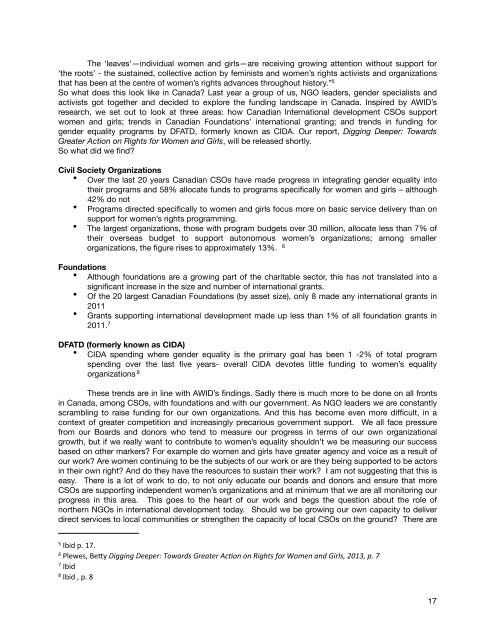Undercurrent-Issue-Fall-Winter-2014-3
Undercurrent-Issue-Fall-Winter-2014-3
Undercurrent-Issue-Fall-Winter-2014-3
You also want an ePaper? Increase the reach of your titles
YUMPU automatically turns print PDFs into web optimized ePapers that Google loves.
" The ‘leaves’—individual women and girls—are receiving growing attention without support for‘the roots’ - the sustained, collective action by feminists and women’s rights activists and organizationsthat has been at the centre of women’s rights advances throughout history.” 5So what does this look like in Canada? Last year a group of us, NGO leaders, gender specialists andactivists got together and decided to explore the funding landscape in Canada. Inspired by AWID’sresearch, we set out to look at three areas: how Canadian International development CSOs supportwomen and girls; trends in Canadian Foundations’ international granting; and trends in funding forgender equality programs by DFATD, formerly known as CIDA. Our report, Digging Deeper: TowardsGreater Action on Rights for Women and Girls, will be released shortly.So what did we find?Civil Society Organizations• Over the last 20 years Canadian CSOs have made progress in integrating gender equality intotheir programs and 58% allocate funds to programs specifically for women and girls – although42% do not• Programs directed specifically to women and girls focus more on basic service delivery than onsupport for women’s rights programming.• The largest organizations, those with program budgets over 30 million, allocate less than 7% oftheir overseas budget to support autonomous women’s organizations; among smallerorganizations, the figure rises to approximately 13%. 6Foundations• Although foundations are a growing part of the charitable sector, this has not translated into asignificant increase in the size and number of international grants.• Of the 20 largest Canadian Foundations (by asset size), only 8 made any international grants in2011• Grants supporting international development made up less than 1% of all foundation grants in2011. 7DFATD (formerly known as CIDA)• CIDA spending where gender equality is the primary goal has been 1 -2% of total programspending over the last five years- overall CIDA devotes little funding to women’s equalityorganizations 8" These trends are in line with AWID’s findings. Sadly there is much more to be done on all frontsin Canada, among CSOs, with foundations and with our government. As NGO leaders we are constantlyscrambling to raise funding for our own organizations. And this has become even more difficult, in acontext of greater competition and increasingly precarious government support. We all face pressurefrom our Boards and donors who tend to measure our progress in terms of our own organizationalgrowth, but if we really want to contribute to women’s equality shouldn’t we be measuring our successbased on other markers? For example do women and girls have greater agency and voice as a result ofour work? Are women continuing to be the subjects of our work or are they being supported to be actorsin their own right? And do they have the resources to sustain their work? I am not suggesting that this iseasy. There is a lot of work to do, to not only educate our boards and donors and ensure that moreCSOs are supporting independent women’s organizations and at minimum that we are all monitoring ourprogress in this area. This goes to the heart of our work and begs the question about the role ofnorthern NGOs in international development today. Should we be growing our own capacity to deliverdirect services to local communities or strengthen the capacity of local CSOs on the ground? There areI"B(&2"-1"!E1!"J')0);?"C),7"#$%%$&%"#''(')*"+,-.)/0"1)'.2')"345,&",&"6$%720"8,)"9,:'&".&/"1$);0


